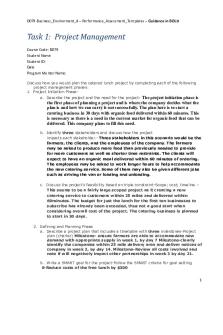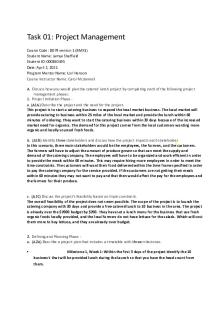TET1 Task 1 - Task 1 essay PDF

| Title | TET1 Task 1 - Task 1 essay |
|---|---|
| Course | Issues in Technology |
| Institution | Western Governors University |
| Pages | 6 |
| File Size | 88.9 KB |
| File Type | |
| Total Downloads | 20 |
| Total Views | 160 |
Summary
Task 1 essay...
Description
TET1 Task 1: Ethics
Ashley Henry February 1, 2021 Mentor: Angela Rose Student ID: 001351528
A Written project to the Faculty of the Teachers College of Western Governors University
TET1 Task 1: ETHICS This paper will be discussing the many issues that using technology in the classroom can bring as well as the understanding a teacher must have in order to teach students how to use technology safely. Some of these issues include the legal, ethical, copyright, and safety concerns associated with technology. Throughout this paper you will find an instructional setting and intended audience, the protective measures for three threat situations, and the safe practices for using technology in the classroom. In addition to this written report, a PowerPoint presentation has been created as a visual aide for the intended audience. Instructional Setting The instructional setting is a first grade classroom at a Title I school located in a rural area. The school has three first grade classes with a total of fifty-five students. The classroom is supported by one general education teacher as well as many pull out supports like special area teachers and special education assistants. This classroom is also supported by one half-day teacher assistant. Each student in this classroom has access to their own Chromebook provided by the school system. On their Chromebook, the students access technology apps like Google Classroom, digital library resources, math fluency applications, typing programs, and many other educational websites. Learners in the Instructional Setting The learners in the instructional setting are a class of 17 first grade students. There are 10 girls and 7 boys in the class, all between the ages of six and seven. One of the seventeen students is and English Language Learner, whose native language is Spanish. One student has an individualized learning plan for both learning and speech disabilities. On their beginning of the
year benchmark reading tests 10 students are identified as performing below grade level, with the remaining 7 students identified as performing on or above grade level. Protective Measures for Safeguarding Electronic Resources The first threat that will be discussed is inappropriate content. This threat is especially important when working with primary level students. Although the internet is one of the most useful tools for research, online instruction, and entertainment, it is also one way to access “inappropriate information for children, such as pornography, hate literature, aggressive advertising, and violent images” (“Guidelines and Resources for Internet Safe3ty in Schools”, 2007). In order to prevent the access of this inappropriate information is to develop protective measures like school or system wide policies. In addition to developing these policies, unwanted sites can be blocked so students do not have any access to them. Once both of these protective measures have been put into place, then teachers can help educate students on technology safety and monitor student use. These protective measures, as well as the federal laws such as FERPA will help ensure that student access to inappropriate content is avoided. The next threat to be discussed is online predators. Often times online predators can be sexual predators that “deceive students by pretending to be students themselves” (“Guidelines and Resources for Internet Safety in Schools”, 2007). For example, the intended audience of first grade students should not have any online communication whatsoever. In order to ensure that they do not have any communication, they will first be limited to only school approved sites and signed up for those sites by their teacher or school district. By only using sites that students cannot have public communication on and by monitoring student use of sites, then predators can be avoided. School districts may choose to take this safety protocol a step further by creating
their own network. These extra steps allow teachers and students to communicate without any outsiders gaining access to their information. The final threat is Cyberbullying. This threat is becoming more and more common everyday as students gain more access to technology. A recent Google Survey states that cyberbullying is the number one threat security threat for kids in the classroom. It also states that 13.8% of kids experience cyberbullying when using a technology device (Google Survey, 2018). The simplest and most efficient way to safeguard against cyberbullying is similar to safeguarding from online predators by removing any possibility of online communication. However, it is important to educate students on proper online communication and the negative side effects of cyberbullying, so they do not participate in those negative practices outside of the monitored school environment. It is also important to discuss communicating with teachers and parents if students are being bullied online. Teache4rs should inform students of how to be proactive when cyberbullying takes place and how to address the situation with an adult. Safe Practices for Use of Instructional Technology Tools When implementing safe practices for using technology in school, teachers should focus on enforcing policies and monitoring student access and use. Specifically, for primary level students, like the intended audience of first graders, a teacher should develop policies or use policies developed by the school district for the students to use. Before students have access to the technology, they could complete an understanding agreement. For younger users, more images and fewer words should be used to help the students visually grasp the concept of safe technology use. Teachers should also inform students of sites that they can and cannot get on without permission like YouTube and chat sites. As a teacher it is important to help develop and monitor these appropriate activities in your young students.
Establishing Behavioral Expectations in a Teaching Environment In our classroom we have access to 18 Chromebook, one for each student as well as my own Chromebook. These Chromebooks stay in the classroom and are only to be used for school related functions. At the beginning of the year the students complete a technology safety class and then complete an agreement about computer safety. In addition to the students understanding the requirements about technology safety, parents must complete the same technology safety course and sign an agreement for their personal use when working with students. Before the agreement is signed, I hold a presentati9on that includes visuals and specific examples so students of any age can comprehend how important technology safety is. This presentation also includes rules of how to take care of and use an individual Chromebook properly. Once the presentation and agreements are completed, students are given the opportunity to practice using their Chromebook. For the first few days this is done by small group with a teacher or teacher’s aide. Eventually, the class will complete Chromebook Activities in a whole group setting.
References Google Survey, December 2018. Retrieved January 10, 2021 from https://services.google.com/fh/files/blogs/parent_teacher_survey_us.pdf United States of America, Virginia Department of Education., Office of Educational Technology. (2007). Guidelines and Resources for Internet Safety in Schools (2nd ed.). Richmond, VA: United States of America, Virginia Department of Education., Office of Educational Technology. (2007). Guidelines and Resources for internet safety in Schools (2nd ed.). Richmond, VA: Virginia Dept. of Education. Retrieved September 15, 2018, from http://www.doe.virginia.gov/support/safety_crisis_management/internet_safety/guidlines _respurces.pdf TET1 TASK 1: ETHICS 7 References Intranet Software. (2018). Retrieved September 15, 2018, from https://www.cornerstoneondemand.com/glossary/intranet-software McAfee, LLC. (2018). Find your device-to-cloud cybersecurity solutions. Retrieved September 15, 2018, from https://www.mcafee.com/en-us/index.html TeenSafe. (2017, May 08). Cyberbullying Facts and Statistics. Retrieved September 15, 2018, from TET1 TASK 1: ETHICS 7 References Intranet Software. (2018). Retrieved September 15, 2018, from https://www.cornerstoneondemand.com/glossary/intranet-software McAfee, LLC. (2018). Find your device-to-cloud cybersecurity solutions. Retrieved September 15, 2018, from https://www.mcafee.com/en-us/index.html TeenSafe. (2017, May 08). Cyberbullying Facts and Statistics. Retrieved September 15, 2018, from TET1 TASK 1: ETHICS 7 References Intranet Software. (2018). Retrieved September 15, 2018, from https://www.cornerstoneondemand.com/glossary/intranet-software McAfee, LLC. (2018). Find your device-to-cloud cybersecurity solutions. Retrieved September 15, 2018, from https://www.mcafee.com/en-us/index.html TeenSafe. (2017, May 08). Cyberbullying Facts and Statistics. Retrieved September 15, 2018, from...
Similar Free PDFs

TET1 Task 1 - Task 1 essay
- 6 Pages

TET1 Task 3 essay
- 5 Pages

TET1 Task 2 - Task 2
- 4 Pages

PCE Task 1 - Task 1
- 2 Pages

Task 1 - SUS101 Task 1
- 2 Pages

Qht1 task 1 - Task 1
- 3 Pages

QBM1 Task 1 - Task 1
- 5 Pages

C365 - Task 1 - Task 1
- 4 Pages

Task 1 - C226 Task 1
- 11 Pages

C304 Task 1 - TASK 1
- 16 Pages

DIT1 TASK 1 - Task 1
- 4 Pages

D078 Task 1 - task 1
- 2 Pages

Task 1 English 2 essay
- 3 Pages

Task d079 copy - Task 1
- 3 Pages

HMc Daniel Task 1 - Task 1
- 9 Pages
Popular Institutions
- Tinajero National High School - Annex
- Politeknik Caltex Riau
- Yokohama City University
- SGT University
- University of Al-Qadisiyah
- Divine Word College of Vigan
- Techniek College Rotterdam
- Universidade de Santiago
- Universiti Teknologi MARA Cawangan Johor Kampus Pasir Gudang
- Poltekkes Kemenkes Yogyakarta
- Baguio City National High School
- Colegio san marcos
- preparatoria uno
- Centro de Bachillerato Tecnológico Industrial y de Servicios No. 107
- Dalian Maritime University
- Quang Trung Secondary School
- Colegio Tecnológico en Informática
- Corporación Regional de Educación Superior
- Grupo CEDVA
- Dar Al Uloom University
- Centro de Estudios Preuniversitarios de la Universidad Nacional de Ingeniería
- 上智大学
- Aakash International School, Nuna Majara
- San Felipe Neri Catholic School
- Kang Chiao International School - New Taipei City
- Misamis Occidental National High School
- Institución Educativa Escuela Normal Juan Ladrilleros
- Kolehiyo ng Pantukan
- Batanes State College
- Instituto Continental
- Sekolah Menengah Kejuruan Kesehatan Kaltara (Tarakan)
- Colegio de La Inmaculada Concepcion - Cebu
